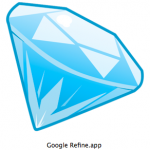Like most places, the University of Bolton keeps its data in many stores. That’s inevitable with multiple systems, but it makes getting a complete picture of courses and students difficult. We test an approach that promises to integrate all this data, and some more, quickly and cheaply.
Integrating a load of data in a specialised tool or data warehouse is not new, and many institutions have been using them for a while. What Bolton is trying in its JISC sponsored course data project is to see whether such a warehouse can be built out of Linked Data components. Using such tools promises three major advantages over existing data warehouse technology:
It expects data to be messy, and it expects it to change. As a consequence, adding new data sources, or coping with changes in data sources, or generating new reports or queries should not be a big deal. There are no schemas to break, so no major re-engineering required.
It is built on the same technology as the emergent web of data. Which means that increasing numbers of datasets – particularly from the UK government – should be easily thrown into the mix to answer bigger questions, and public excerpts from Bolton’s data should be easy to contribute back.
It is standards based. At every step from extracting the data, transforming it and loading it to querying, analysing and visualising it, there’s a choice of open and closed source tools. If one turns out not to be up to the job, we should be able to slot another in.
But we did spend a day kicking the tires, and making some initial choices. Since the project is just to pilot a Linked Enterprise Data (LED) approach, we’ve limited ourselves to evaluate just open source tools. We know there plenty of good closed source options in any of the following areas, but we’re going to test the whole approach before deciding on committing to license fees.
Data sources


Before we can mash, query and visualise, we need to do some data extraction from the sources, and we’ve come down on two tools for that: Google Refine and D2RQ. They do slightly different jobs.
Refine is Google’s power tool for anyone who has to deal with malformed data, or who just wants to transform or excerpt from format to another. It takes in CSV or output from a range of APIs, and puts it in table form. In that table form, you can perform a wide range of transformations on the data, and then export in a range of formats. The plug-in from DERI Galway, allows you to specify exactly how the RDF – the linked data format, and heart of the approach – should look when exported.
What Refine doesn’t really do (yet?) is transform data automatically, as a piece of middleware. All your operations are saved as a script that can be re-applied, but it won’t re-apply the operations entirely automagically. D2RQ does do that, and works more like middleware.
Although I’ve known D2RQ for a couple of years, it still looks like magic to me: you download, unzip it, tell it where your common or garden relational database is, and what username and password it can use to get in. It’ll go off, inspect the contents of the database, and come back with a mapping of the contents to RDF. Then start the server that comes with it, and the relational database can be browsed and queried like any other Linked Data source.
Since practically all relevant data in Bolton are in a range of relational databases, we’re expecting to use D2R to create RDF data dumps that will be imported into the data warehouse via a script. For a quick start, though, we’ve already made some transforms with Refine. We might also use scripts such as Oxford’s XCRI XML to RDF transform.
Storage, querying and visualisation
We expected to pick different tools for each of these functions, but ended up choosing one, that does it all- after a fashion. Callimachus is designed specifically for rapid development of LED applications, and the standard download includes a version of the Sesame triplestore (or RDF database) for storage. Other triple stores can also be used with Callimachus, but Sesame was on the list anyway, so we’ll see how far that takes us.
Callimachus itself is more of a web application on top that allows quick visualisations of data excerpts- be they straight records of one dataset or a collection of data about one thing from multiple sets. The queries that power the Callimachus visualisations have limitations – compared to the full power of SPARQL, the linked data query language – but are good enough to knock up some pages quickly. For the more involved visualisations, Callimachus SPARQL 1.1 implementation allows the results a query to be put out as common or garden JSON, for which many different tools exist.
Next steps
We’ve made some templates already that pull together course information from a variety of sources, on which I’ll report later. While that’s going on, the main other task will be to set up the processes of extracting data from the relational databases using D2R, and then loading it into Callimachus using timed scripts.